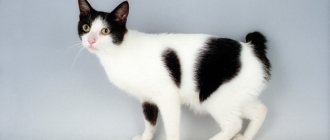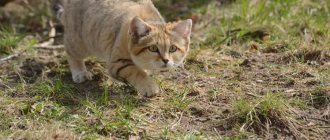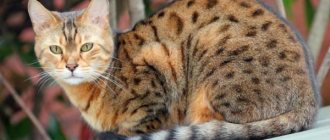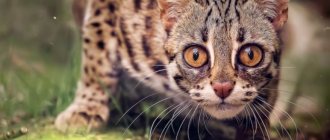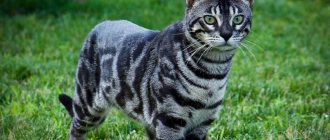- Wild animals
- >>
- Mammals
The Caracal is a cute cat with a streamlined, sleek body, short, golden-reddish fur and distinctive facial markings. These are one of the most beautiful species of wild cats on Earth, also called the desert lynx. Caracals have no spots or stripes, and they have longer legs and a slimmer body than the true lynx.
They are the heaviest and also the fastest of the small cats in Africa. The anatomical adaptations that give the caracal its extraordinary beauty and athleticism are the result of 35 million years of felid evolution.
Origin of the species and description
Photo: Karakal
The caracal's place in the cat family tree is somewhat confusing, but it is believed to be directly related to the serval and golden cat. The caracal's habitat is different from its feline cousins. Servals and caracals are similar in size, however servals hunt in wet habitats while caracals stick to drier areas.
Character and habits of caracals
The character of the caracal is more like a dog than a cat. These are real hunters who love to run, jump, and swim. Natural conditions have made caracals hardy and extremely active.
Since the breed began to be domesticated, domestic Caracal cats have become more affectionate and friendly. If raised correctly from childhood, the pet will become a faithful and devoted friend who will protect its owner.
Caracal - a loyal breed
This unusual breed should not be owned by families with small children. The caracal does not show aggression unless provoked, so it is better to wait until the child is older.
Individuals need a lot of space. They live well in houses with an aviary or in country houses. The apartments will be cramped for caracals.
Caracals are cramped in small apartments
Video: Caracal
Adaptation and diversity of prey in different habitats and areas of different sizes indicate that the caracal is not endangered as a species. The results of phylogenetic studies show that the caracal and the African golden cat (C. aurata) diverged in their development between 2.93 and 1.19 million years ago. These two species, together with the serval, form the Caracal genetic line, which in turn dispersed between 11.56 and 6.66 million years ago. The ancestor of this lineage arrived in Africa somewhere between 8.5 and 5.6 million years ago.
"Felis caracal" is the scientific name used by Johann Daniel von Schreber in 1776, who described the skin of the cheetah from the Cape of Good Hope. In 1843, British zoologist John Gray placed it in the genus Caracal. It is placed in the family Felidae and subfamily Felinae. In the 19th and 20th centuries, several individuals of the caracal were described and proposed as a subspecies.
Since 2021, three subspecies have been recognized by scientists as valid:
- southern caracal (C. Caracal) - found in Southern and Eastern Africa;
- northern caracal (C. Nubicus) - found in North and West Africa;
- Asian caracal (C. Schmitzi) - found in Asia.
The name "caracal" consists of two Turkic words: kara, meaning black, and kulak, meaning ear. The first recorded use of this name dates back to 1760. An alternative name is Persian lynx. The Greeks and Romans most likely applied the name "lynx" to caracals. This name is sometimes still applied to the caracal, but the modern lynx is a separate species.
Appearance and features
Photo: Caracal animal
The caracal is a slender cat characterized by a strong build, short face, long dog-like teeth, tufted ears and long legs. It has brown or red fur, the color of which varies among individuals. Females are lighter than males. Their undersides are white and, like the African golden cat, decorated with many small spots. The fur itself, soft, short and dense, becomes coarser in summer.
The ground hair (the main layer of hair covering the coat) is denser in winter than in summer. The length of the guard hairs can reach 3 cm in winter, but shorten to 2 cm in summer. There are black markings on the face: on the whisker pads, around the eyes, above the eyes and slightly down the center of the head and nose.
A distinctive feature of caracals is the elongated, black tufts above the ears in the form of tassels. There are many theories about their purpose. Tufts can keep flies away from a cat's face or help camouflage themselves in long grass to break up the outline of the head. But, the most common version is that the cat moves its ear tufts when communicating with other caracals.
The legs are quite long. The hind legs are disproportionately high and muscular. The tail is short. Eye color varies from golden or copper to gray or green. Melanistic individuals have been recorded but are extremely rare.
Juveniles are distinguished by shorter ear tufts and blue tinted eyes. The C. caracal subspecies may not differ in phenotype. Females are smaller and weigh up to 13 kg, while males can weigh up to 20 kg. The tail is shortened, but it still makes up a significant part of the total body length. The length of the tail varies from 18 cm to 34 cm. The length of the head and body from the nose to the base of the tail ranges from 62 to 91 cm. Even the most miniature adult caracal is larger than most domestic cats.
Where does the caracal live?
Photo: Caracal cat
The caracal's habitat extends through Africa through the Middle East all the way to India. It is perfectly adapted to the harsh everyday life in the savannah, dry forest, semi-desert, arid hilly steppe and dry mountains. In Africa, the caracal is widespread in sub-Saharan Africa, but is considered rare in North Africa. In Asia, its range stretches from the Arabian Peninsula, along the Middle East, Turkmenistan, Uzbekistan to western India.
The population is disappearing in North Africa, but there are still many caracals in other African regions. Their settlement limits are the Sahara Desert and the equatorial forest belt of Western and Central Africa. In South Africa and Namibia, C. caracal is so numerous that it is exterminated as a nuisance. Asian populations are less numerous than African ones.
Interesting fact: Caracals were once trained to hunt birds in Iran and India. They were placed in an arena containing a flock of pigeons, and bets were placed on how many birds the cat could kill in one jump.
The species inhabits forests, savannas, swampy lowlands, semi-deserts and scrub forests, but prefers arid areas with little rainfall and shelter. In mountainous habitats, this occurs at an altitude of up to 3000 m. A dry climate with limited leaf cover is preferable for the animal. Compared to servals, caracals can tolerate much drier conditions. However, they rarely inhabit deserts or tropical areas. In Asia, caracals are sometimes found in forests, which is not typical for African populations.
In Benin's Pendjari National Park, the movement of caracals was recorded by camera traps. In the Emirate of Abu Dhabi, a male caracal was discovered using camera traps in Jebel Hafeet National Park in February 2021, the first time since 1984. In Uzbekistan, the caracal has only been recorded in the desert areas of the Ustyurt Plateau and the Kyzylkum Desert. Between 2000 and 2021, 15 individuals have been spotted alive and at least 11 have been killed by herders.
Caracal (steppe lynx). Photo and video.
The caracal (steppe lynx) is a predator, a mammal of the cat family. For a long time, the caracal was classified as a lynx, since it resembles them in appearance, but after a series of genetic studies it was separated into a separate genus. But still, caracals are closer to lynxes than other cats.
In appearance, the caracal resembles a lynx, only smaller in size, more slender and with a uniform coat color. Body length is 65-82 cm, tail – 25-30 cm, height – approximately 45 cm, weight – 11-19 kg. There are tassels up to 5 cm long at the tips of the ears.
On the paw pads there is a brush made of hard hair, which makes it easier to move through the sand. Well, in general, the size of a caracal does not exceed the size of an ordinary cocker spaniel dog.
The fur is thick and short. In color, the caracal is similar to the North American puma - brown-red fur on top, whitish below, there are black markings on the side of the muzzle. The tassels and ears are black on the outside.
Melanistic caracals with black fur are extremely rare. The color of an animal's fur is largely influenced by its habitat and hunting location. For example, the Israeli caracal has a much paler coat than the one living in India, and some Iranian species have black fur and silver tassels on the ears.
In some African countries, these animals are called “red cats” for their copper-colored fur, in some – “gazelle cats” for their extraordinary mobility and lightness.
Although the caracal is similar in appearance to a lynx, morphologically it is closer to the puma. Also close to it is the African serval, with which the caracal easily interbreeds in captivity.
At first glance, the caracal's face is very similar to that of a cat. The only difference is the large triangular ears, topped with long black tassels. In young caracals, the tassels are almost in a vertical position, but over time their elasticity is lost, and they begin to hang from the ears like ribbons.
Just don’t be impressed by its good looks and small size. Caracals are strong and dangerous predators, far-sighted and experienced hunters, capable of pursuing prey whose weight is twice its own weight.
It pierces the throat of its prey with sharp fangs, and holds it with its powerful jaws so that the prey does not escape from its pursuer. The claws and molars are sharp, like blades, with which the caracal cuts prey and separates the meat from the tendons.
The most powerful weapon of this animal can be called its hind legs, muscular and strong, which even an Olympic-level jumper or sprinter would envy. They give the caracal amazing agility. Also, these animals have well-developed hearing, being unusually acute, they see perfectly in the dark.
Amazing ears, controlled by twenty muscles, help the caracal hear the noise of an approaching victim when the night is dark all around. There are many hairs inside the ear, which help determine the location of prey as accurately as possible.
The name “caracal” comes from the Turkish word “karakulak” - “black ear”. The explanation for this name is the black back of the ears of caracals. The population of North Africa calls the karcal "Barbary lynx."
Caracals are found in deserts, savannas, foothills of Africa, deserts of Central and Asia Minor, and the Arabian Peninsula. Also, these animals can be found, only infrequently, in the desert of Southern Turkmenistan, on the coast of the Caspian Sea (up to the Mangyshlak Peninsula), and occasionally found in Uzbekistan, in the Bukhara region.
Different subspecies of caracals are common in different areas:
· In South Africa and Sudan – Caracalcaracalcaracal.
· In North Africa – Caracalcaracalalgira.
· In Namibia – Caracal caracal damarensis.
· In Botswana – Caracal caracal limpopoensis.
· In Gabon – Caracal caracal luciani.
· In Turkmenistan – Caracal caracal michaelis (Turkmen caracal). This subspecies is endangered, the total number of remaining individuals is no more than 300.
· In Ethiopia and Sudan – Caracalcaracalnubica.
· In Nigeria – Caracal caracal poecilictis.
· From Anterior India to Arabia - Caracalcaracalschmitzi (Indian caracal).
Caracals are active mainly at night, but in winter and spring they can also be found during the day. These animals choose fox or porcupine burrows and rock crevices as their shelters. Caracals can live in one shelter for several years.
The territories occupied by males have a large area, while females get smaller areas on the periphery.
The long legs of the caracal allow it to jump up to 4.5 m in length, which it actively uses when hunting, but it cannot run for a long time. An unusually high reaction speed and very sharp retractable claws enable the caracal to grab more than one bird from a flock that has begun to take off. But the main food of this animal is rodents (jerboas, gerbils, gophers), tolai hares, sometimes small antelopes, and in Turkmenistan, goitered gazelles.
Sometimes the caracal preys on porcupines, hedgehogs, insects, reptiles, small predators (mongooses or foxes), and young ostriches. Capable of kidnapping poultry, attacking goats and lambs. Caracals can go without water for a long time; they only need the liquid contained in the prey they eat.
Like the leopard, the caracal hides its caught prey in a tree, away from other predatory animals.
Caracals breed all year round, depending on their habitat; a female can have three partners during her estrus, which lasts six days. Gestation lasts 61-79 days, and 1 to 6 spotted blind cubs are born.
The older caracals become, the fewer spots remain on their skin. A week after birth, the kittens' eyes open, and two to four days later they begin to stand up and walk. The cubs grow slowly, with an average daily weight gain of approximately 21 grams.
Until the babies are one month old, the female carries them from den to den every day. Having reached a certain age, usually a year, the young caracal leaves its mother to settle in its own domain. Females settle close to the parental territory, and males go far - from 100 km. Sexual maturity is reached at the age of 16-18 months.
Caracals lead a fairly solitary life, with the exception of the breeding season. Occasionally you can find family groups with a small number. The area of an individual male's territory is 95-350 km2, it partially overlaps with the domains of other males; females have smaller territories - 2-112 km2.
Caracals can be easily tamed. In Persia and India, tame animals were used to hunt hares, peacocks, pheasants, and small antelopes. In ancient times, this type of hunting was very popular in eastern countries.
In India, the caracal was given the name “little cheetah” or “cheetah for the poor”, since, unlike the cheetah, it was caught and kept by poor people. Nowadays such hunting is rare.
In Africa, mainly in the south, caracals are common animals that are even considered pests. There is a special ritual for hunting caracals: they are lured with devices that can imitate the cry of a mouse or a wounded hare, and they are shot at night from under headlights. In addition, caracals are used in South Africa to drive away birds (mainly guinea fowl) from the runways of military airfields.
The subspecies of caracals found in Asia are much rarer and are even listed in the IICITIES Appendix.
Here is what the Red Book of Kazakhstan writes about the caracal:
· Status. First category. The species is rare and endangered. Listed in the IUCN Red List.
· What does a taxon mean for the conservation of the gene pool. The desert cat, very peculiar, is the only representative of the caracal subgenus. Central Asia is the habitat of a special Turkmen subspecies; the northern part of the range is occupied by Kazakhstan.
· Spreading. The limits of the Mangistau region are on Ustyurt (mostly near the Northern, Western and Southern cliffs), the Mangyshlak, Buzachi, Tyub-Karagan peninsulas, in the large sandy massifs of Tuesu, Karynzharyk, Sengirkum, Bostankum, Mataikum, Sam, etc. Previously, caracals were found in Northern Kyzylkum.
· Habitats. Caracals are typical inhabitants of semi-fixed sands, which are overgrown with comb grass, saxaul, dzhuzgun and other types of shrubs. They can also be found in pre-chink zones and on the chinks themselves, in hilly areas of the desert with clay soil and small bushes, in treeless low mountains and partially deserted foothills, along river beds overgrown with black saxaul and tamarisk. As sandy massifs are increasingly subject to development, many caracals are forced into ravines and onto kyra plains.
· Number. Rare animal. The size of the population depends on the number of species that form the basis of food - yellow ground squirrel, tolai hare, great gerbil. In 1951-1994, about twenty caracals were caught in the Mangistau region, and about fifteen were encountered. Consequently, it lives in Kazakhstan. Apparently, up to several dozen animals. In the north-west of Turkmenistan, under the same habitat conditions, the population density of caracals in 1986 was 0.5-1.5 per 100 km. way, in some areas it reached 3-6 individuals per 100 km.
· What are the main limiting factors? Firstly, this is poaching. Secondly, the population of rodents and the tolai hare is falling. Thirdly, winters have become snowy and harsh, and caracals are not adapted to this.
· Biological features. Except in the cold season, it is nocturnal. Eats a varied diet. About a quarter of the diet consists of tolai hares, a little less - yellow ground squirrels, followed by large gerbils. In addition to the above, caracals eat jerboas, hedgehogs, foxes, steppe cats, birds (audotka, jack, chukar, hazel grouse, pigeon), reptiles, arthropods, etc. They can attack young Ustyurt rams, goitered gazelles, and sometimes sheep. In Turkmenistan they do not disdain porcupines. Lives in former burrows of porcupines and foxes. In the warm season, it often makes its home under bushes. Caracal babies are born in early April. Pregnancy lasts approximately 70 days, with a litter of 3-4 cubs. The enemies of the caracal are wolves and shepherds' dogs. Young animals can also be harmed by large birds of prey. Competitors include the same birds, as well as steppe cats and foxes.
· Breeding. Caracals are kept in zoos in Moscow, Tashkent, Berlin, Vilnius and others. Reproduction in captivity is possible.
· Security measures taken. The Karagiye-Karakolsky and Aktau-Buzachinsky nature reserves and the Ustyurt nature reserve were created.
· Security measures that would be nice to take. It is necessary to create a network of protected areas in the Mangistau region, expand the territory of the Ustyurt Nature Reserve, and organize new reserves - Zhabayushkansky and Besbulaksky, with an area of about 500 thousand hectares each.
More interesting articles on the topic:
Mmm, this is a pie...
What's that strange smell? A! Yes, this is a quiche with... a brown ferret!
Bottlenose dolphin, or large dolphin (lat. Tursiops truncatus). Description, photo and video of bottlenose dolphin
The bottlenose dolphin, in other words - Tursiops truncatus, or more simply - a large dolphin, is
Hamster sleeps in a plastic cup
Hello! When I get tired of running on my trainer, I really like to wear it in Rosk
Real or toy?
Do you think this is a real bunny? But no! This is what the “living” people make these days and
Narwhal, or Monodon monoceros. Description, photos and videos of the narwhal.
Narwhal belongs to cetacean mammals and is the only species of the genus
Pangolin
Pangolin ("rolling ball" in Malay) is found
What does a caracal eat?
Photo: Caracal desert lynx
Caracals are strictly carnivores. The main components of the diet vary depending on the geography of residence. African cats can consume larger animals such as ungulates, while the Asian cat only eats small vertebrates such as rodents. Livestock are rarely attacked. Although caracals are known for their spectacular leaps to catch birds, more than half of their diet consists of mammals across all ranges.
The main part of the caracal menu consists of:
- rodents;
- hyraxes;
- hares;
- birds;
- small monkeys;
- antelope.
Doves and partridges are of seasonal importance to the species.
In addition, they can sometimes hunt:
- mountain redunks (African antelopes);
- Gazelle Dorcas;
- mountain gazelles;
- gerenuk;
- stenboks;
- African Bustard.
Caracals consume some reptiles, although this is not a common component of the diet. They are unique among cats of their size and can kill prey two to three times their body weight. Small prey are killed by a bite to the back of the head, while larger prey are killed by a suffocating bite to the throat. Prey is usually captured when the caracal leaps using its disproportionately elongated and muscular hind legs.
Fun fact: The Caracal is capable of jumping into the air and knocking down 10-12 birds at the same time!
Before eating its prey, the caracal often “plays” for 5-25 minutes, moving it with its paws. The caracal can even throw a small victim into the air and then grab it in flight. The reasons for this behavior are unclear. Like a leopard, the caracal can climb trees and sometimes stores large prey on branches to return to later. This prevents the prey from being eaten by hyenas and lions, allowing the caracal to make the most of its hunting success. Its large retractable claws and powerful legs give it this climbing ability.
Features of character and lifestyle
Photo: Lynx caracal
The caracal is nocturnal, although some activity can be observed during the day. However, this cat is very secretive and difficult to observe, so its activity during the day can easily go unnoticed. A study in South Africa found that caracals are most active when temperatures drop below 20°C. Activity generally declines at higher temperatures. The caracal is mostly found alone. The only recorded groups are mothers and their offspring.
The caracal is an unusually beautiful animal, shaped by natural selection. It is well adapted to various habitats and conditions. Unlike many species, it is able to survive for long periods of time without drinking water, and its amazing jumping ability gives it an almost superhuman nature.
They are a territorial animal and mark the space they occupy with urine and probably feces that are not covered with soil. It is known that one caracal can drive away predators twice its size. Hunting times are usually determined by prey activity, but C. caracal is most often observed hunting at night. In Israel, males have an average of 220 km² and females 57 km². Male territories range from 270–1116 km² in Saudi Arabia. In Mountain Zebra National Park (South Africa), female territories range from 4.0 to 6.5 km².
These areas overlap greatly. Visible ear tufts and face coloring often serve as a method of visual communication. Caracals are observed interacting with each other by moving their heads from side to side. Like other cats, the caracal meows, growls, hisses and purrs.
Character
The character of a caracal is largely determined by upbringing. Unlike other cats - with the possible exception of the cheetah - the caracal is highly trainable and recognizes the “rules of subordination” if the owner takes the time to instill them in the kitten at an early age. The caracal is a predator, and it is very important that in its manifestations the animal does not go beyond what is permitted. Caracals are not prone to mood swings and manifestations of anger - however, they are not prone to traditional manifestations of feline tenderness either. They are very curious, energetic and love to play. The owner’s task is to make sure that the manifestation of these traits does not become destructive, for example, he does not get into the habit of biting household members for fun or destroying furniture. In the first two years, the kitten can be quite emotional, this should be taken into account and patience and perseverance should be shown. The help of professionals will not be superfluous. Rudeness and punishment are contraindicated.
As in the wild, caracals jealously defend their territory. Even a well-bred animal marks it from time to time, and both cats and cats do this. Tolerant of intrusion by the owner and members of his family, he can react aggressively to strangers. The caracal is a strong animal, and it is not easy to cope with it.
Social structure and reproduction
Photo: Caracal kittens
Before mating begins, females spread urine, the smell of which attracts and notifies the male that she is ready to mate. The distinctive sound mating call is also an attraction method. There have been several different forms of mating systems observed for caracals. When a female is courted by multiple males, the group may fight to mate with her, or she may select her partners, preferring older, larger males.
Mating occurs with several partners over the course of a week. When the female chooses a mate. The couple can stay together for up to four days, during which copulation occurs several times. Females almost always copulate with more than one male. Although both sexes become sexually mature between 7 and 10 months of age, successful copulation will occur between 14 and 15 months of age.
A female can go into estrus at any time during the year. This is associated with the control of the female’s nutrition. When there is a relative abundance of food (which varies among habitats), the female will enter estrus. This explains the peak birth dates between October and February in some regions. A woman cannot have more than one litter per year. The gestation period ranges from 69 to 81 days, and the female gives birth to 1 to 6 kittens. In the wild, no more than 3 kittens are born.
Females invest a lot of time and energy into their young. A tree cavity, abandoned burrow or cave is often chosen for birth and the first four weeks of postnatal development. At the same time, babies begin to play and eat meat. Care continues until the kittens are about 15 weeks old, but they will gain true independence only at 5-6 months.
Reproduction
Before mating begins, chemical signals in the female's urine attract the male and notify him that she is ready to mate. The distinctive cough-like vocalization is also a way of attracting mates. Several different forms of mating systems characteristic of the species have been observed. When several males are courting a female, there may be a struggle between them for the right to mate, or the female may choose a partner on her own, preferring older and larger ones over young and small ones. Once paired, caracals stay together for four days and mate frequently. Copulation lasts on average less than five minutes. Cats almost always mate with more than one male. For males, infanticide is observed, after which the female, prematurely, begins estrus and ends lactation.
Although both sexes become sexually mature at 7 - 10 months, the earliest successful mating occurs at 14 - 15 months of age. Some biologists believe that sexual maturity is indicated by a body weight of 7 to 9 kg. Females exhibit estrus behavior for 3 to 6 days, but in reality, it lasts twice as long. Estrus can begin at any time during the year. Pregnancy lasts 68 - 81 days, and the number of kittens in the litter varies from 1 to 6. In the wild, as a rule, no more than 3 cubs are born, while in captivity, there are more of them, but rarely exceed 6 kittens.
Parental education plays a large role in reproductive behavior. The time a mother spends with her kittens (and the absence of postpartum estrus) limits the female to one litter per year. Once pregnancy occurs, the male plays no role in rearing. Mothers invest a lot of time and energy into their offspring. Holes in trees, caves, or abandoned burrows are often chosen for the birth of young and the first four weeks of their lives. A month later, the cubs come out of hiding. Around this time, kittens begin to play and eat meat. Breastfeeding continues until the kittens reach 15 weeks of age, but full independence occurs at 5 to 6 months.
Natural enemies of caracals
Photo: Caracal Red Book
External camouflage is the main defense against predators. Caracals prefer open spaces to roost in, so when threatened, they lie flat on the ground, their brown fur acting as instant camouflage. In addition, they move very quickly over rocky terrain, which also helps them avoid large predators:
- Lviv;
- hyenas;
- leopards
However, the listed predators rarely hunt caracals; their main enemy is humans. People kill them for attacking livestock, although this only occurs in some of the animal's ranges, but leads to a large number of deaths (2219 animals in one area). This is particularly the case in South Africa and Namibia, where predator control programs have been introduced. Even with various programs in place, caracals are quickly overpopulating farmland.
It is also attacked for its skin and its meat, which is considered a luxury by some tribes. Although losses from this type of activity are insignificant, since caracal skins are not in demand among other nationalities. The caracal can live up to 12 years in the wild, and some adult caracals live up to 17 years in captivity.
Although caracals are both predator and prey, they are not regularly hunted by lions and hyenas. The greatest impact carcasses have on ecosystems is as population control of other species. They consume whatever is available and use the least amount of energy to catch and kill. In some regions, caracals are one of the few species that kill certain types of prey.
Population and species status
Photo: Caracal cat
The actual number of caracals in the wild is unknown, so a thorough assessment of their population status is impossible. They are considered rare or endangered in Asia and North Africa. In central and southern Africa they are considered widespread and are hunted wherever they are found. Poisoned carcasses, which kill many carnivores, are released by ranchers to kill predators.
Between 1931 and 1952, an average of 2,219 caracals per year were killed in South Africa during anti-predator operations. Namibian farmers who responded to a government questionnaire reported that up to 2,800 caracals were killed in 1981.
Fun Fact: An additional threat is severe habitat loss. As people move further into the area, the animals are driven away and the persecution intensifies.
Locals kill caracals to protect their livestock. It is also at risk of being caught in the animal trade in the Arabian Peninsula. In Turkey and Iran, caracals often die in road accidents. In Uzbekistan, the main threat to caracals is killing by herders in retaliation for livestock losses.
What kind of animal is this - caracal
The name of the cat is literally translated from Turkish as “black ears”. The animal is otherwise called “steppe lynx”. This breed appeared recently - in the 18th century, but even now these animals are considered rare and are in danger of extinction. Several years ago, cats turned into exclusive pets - it is possible that thanks to this it will be possible to maintain their population.
The caracal becomes domesticated so that its population can be maintained
The caracal is classified as a mammalian carnivore of the cat family. In appearance, the animal is similar to a lynx, so until recently it belonged to this population, but was later separated into a separate genus. As for morphological characteristics, in this case the caracal can be compared with a puma or an African serval, with which, by the way, the animal mates well at home. The caracal is listed in the International Red Book (second category) as an endangered animal.

